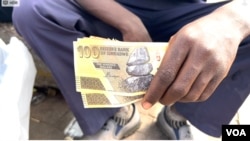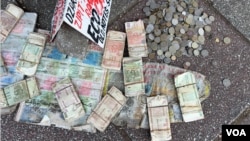Zimbabwe’s recently introduced gold-backed currency is sliding on the local black market but officials insist the currency is getting stronger and has a bright future. Columbus Mavhunga reports from Harare.
Even songs are played on the radio encouraging citizens to embrace the currency, called Zimbabwe Gold — or ZiG — introduced on April 5 trading at 13.56 to the U.S. dollar.
Official statistics say ZiG is now trading at 13.41. But on the black market it is around 20.
Chamunorwa Musengi, a street vendor in Harare, is not optimistic about the new currency which for the moment is trading electronically, with notes and coins coming into circulation on April 30:
“Let’s wait and see,” he said. “Maybe it will boost our economy for some time. But I do not see anything changing with the new currency, because things are really tight at the moment. We been through this before. When they introduced bond notes, things stabilized for a short time and then it started sliding on the market. They are saying ZiG is around 13 — it will end up around 40,000 against the dollar.”
Bond notes refer to the currency which was launched in 2019 after a decade of Zimbabwe using the U.S. dollar and other currencies. The bond note had lost about 80% of its value and was trading at around 40,000 to the dollar before its official demise.
Samson Kabwe, a minibus conductor, says he cannot wait for the physical notes and coins of ZiG to be released.
“We are for ZiG, especially for change,” he said. “We had no small notes for change. If ZiG notes and coins come, the government would have done a great thing. We want it like now.”
The government says for now, commodities like fuel will still be bought and sold using U.S. dollars.
Gift Mugano, an economics professor, predicts the new currency will go the way of the abandoned one.
“[In] 2016, we introduced bond notes which was backed by Afreximbank (African Export–Import Bank) facility of $400 million,” he said. “The Afreximbank is an international bank with reputation. But that was not be sufficient to guarantee the success of the bond notes. So it failed. Right? Why are we failing to guarantee stability? There is no sustained production in the economy because you defend the economy with production. Secondly, confidence issues. People do not trust this system because we have lost money several times.”
But John Mushayavanhu, the new governor or the Reserve Bank of Zimbabwe, predicts the currency will succeed because it is backed by reserves of gold and other minerals worth $175 million and $100 million cash.
“We are doing what we are doing to ensure that our local currency does not die,” he said. “We were already in a situation where almost 85% of transactions are being conducted in U.S. dollars because [the] local currency was not living up to the function of store of value. We are going to restore that store of value so that we can start reviving our currency. So, we are starting at $80 million worth, and as we get more reserves, we will gradually be moving towards greater use of the local currency. It is my wish that if we get to the year (end) at 70-30, next year 60-40, the year after 50-50; by the time we get to 50-50 people will be indifferent as to which currency they are using. And that way we regain use of our local currency.”
While Mushayavanhu has that confidence, social media is awash with people and traders — including government departments — refusing to accept the outgoing Zimbabwe currency.











